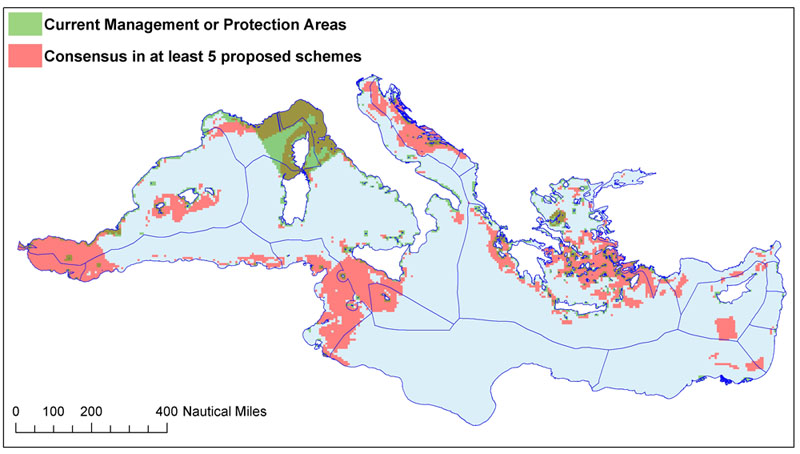An international work, involving CSIC, proposes a network of areas to prioritize in order to advance the protection of the Mediterranean sea. The areas have a total of 250.000 km2, 10% of the sea, and have been chosen for their characteristics of interest. In Spain, the most important areas to protect are: a band of sea from Cap de Creus to Marseilles; areas around the Balearic Islands, and the area between Gibraltar, the Cape of Almeria and the Moroccan coast.
 Several marine areas surrounding the Balearic Islands, especially to the south, and the area between Gibraltar, the Cape of Almería and the coast of Morocco, have been identified as areas of particular interest and should be protected by the year 2020, according to the findings of an international work that has involved the Instituto de Ciencias del Mar of CSIC and has been published in the journal PLoS oNE.
Several marine areas surrounding the Balearic Islands, especially to the south, and the area between Gibraltar, the Cape of Almería and the coast of Morocco, have been identified as areas of particular interest and should be protected by the year 2020, according to the findings of an international work that has involved the Instituto de Ciencias del Mar of CSIC and has been published in the journal PLoS oNE.
They are not the only areas proposed: suggested areas also include the sea from the south of Sicily and to the coasts of Tunisia and Libya, the sea off the coast of Croatia, many areas between Greece and Turkey, and a band sea that stretches from Marseille to Cap de Creus and other smaller areas scattered throughout the Mediterranean.
The paper analyses several conservation proposals that have been made from various institutions and organizations in order to discern what are the areas that should be prioritized when it comes to protecting and what criteria (fisheries, biodiversity, endangered species, impacts, etc.) are included. In total, the conservation proposals analysed are eighteen, of which six are already accepted and are being implemented to a greater or lesser extent.
Marta Coll, CSIC researcher at the Instituto de Ciencias del Mar, explains that “the European Union is aiming to achieve by 2020 a 10% of protection in European Seas. The question is to identify which areas should be prioritized: there are a lot of proposals identifying areas worth protecting that have included different criteria. Our study has analysed these proposals, the frequency they have been identified as areas to protect, and which are their features of interest”.
The areas selected to prioritize for protection in this study sum a total of 10% of the surface of the Mediterranean Sea, approximately 250.000 square kilometres. Some of these areas have already some kind of protection.

Marta Coll explains: “To protect the north and western areas, and areas of the open sea in the Mediterranean, we need to prioritize areas. Regarding the areas in the south, there is less information about them, so that is why there are less prioritized areas”.
The Mediterranean is one of the most biologically diverse seas on the planet. Of the 17,000 species described to date in this sea, approximately one fifth are endemic. Its ecosystems are threatened by several human activities, including exploitation of marine resources, habitat loss and degradation of the coastal areas, the occurrence of invasive species and the effect of climate change. In fact, Mediterranean ecosystems are among the most affected by humans.
In the study that is published today, led by Stanford University (USA), there has been participation of researchers from twelve research institutions and universities located around the world. The study is the result of a collaborative working group that aims at advancing conservation planning in the Mediterranean Sea. Its website is: https://sites.google.com/site/conservationmediterraneanws1/
Fiorenza Micheli, Noam Levin, Sylvaine Giakoumi, Stelios Katsanevakis, Ameer Abdulla, Marta Coll, Simonetta Fraschetti, Salit Kark, Drosos Koutsoubas, Peter Mackelworth, Luigi Maiorano, Hugh P. Possingham "Setting priorities for regional conservation planning in the Mediterranean Sea", PLoS ONE, http://dx.plos.org/10.1371/journal.pone.0059038
